Knowde Enhanced TDS
Identification & Functionality
- Active Component
- Enzyme Type
- Ingredient Name
- Ingredient Origin
- Food Ingredients Functions
- Pharma & Nutraceuticals Functions
Features & Benefits
- Benefit Claims (Health)
- Food Ingredients Features
- Product Overview
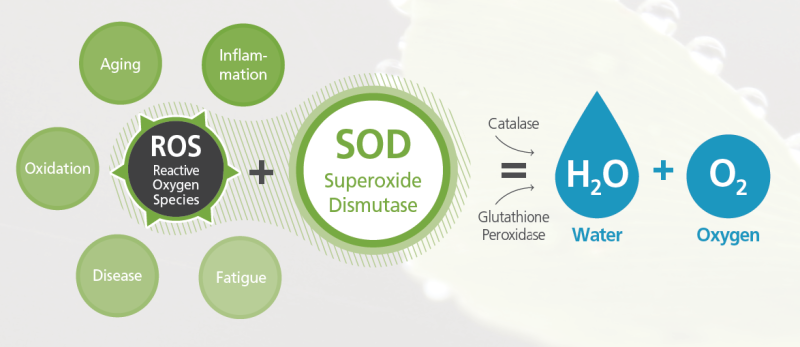 Superoxide dismutase (SOD) converts superoxide to hydrogen peroxide, which is then removed by catalase and glutathione peroxidase
Superoxide dismutase (SOD) converts superoxide to hydrogen peroxide, which is then removed by catalase and glutathione peroxidase- SOD as an Unicorn Ingredient for Dietary Supplements
Anti-Aging
Oxidative stress Systematic inflammation Cardiovascular health Menopausal health Vision improvement Immunity enhancer Joint health
Skin Beauty
Cellulite reduction Anti-wrinkle, hydration Weight management
Well-Being
Stress relief Cognitive performance Sleep healthy Fatigue reduction Exercise-induced oxidative stress
- SOD as a Therapeutic Enzyme
- Inflammatory bowel disease
- Type 2 diabetes
- Atherosclerosis
- Aged realted macular degeneration
- Fibrosarcoma
- Actinic erythema
- Radiation induced fibrosis
- Cognitive memory
- Anti-cancer therapy adjuvant
Applications & Uses
- Markets
- Food & Nutrition Applications
Technical Details & Test Data
- GF Bacillus SOD Benefits Over Technical Results
SOD Enzyme
Superoxide dismutase (SOD) keeps eliminating reactive oxygen species
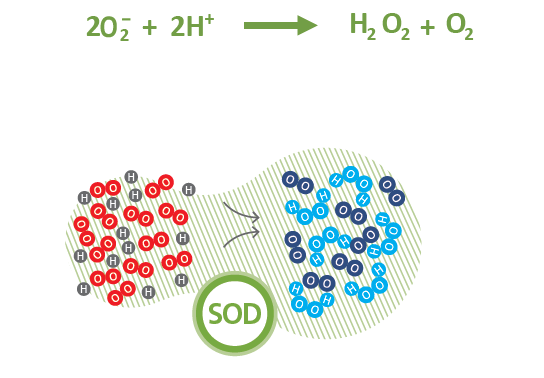
Dietary Antioxidants
Dietary antioxidants are quickly saturated and exhausted
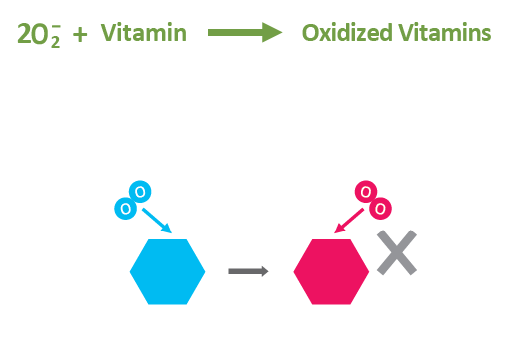
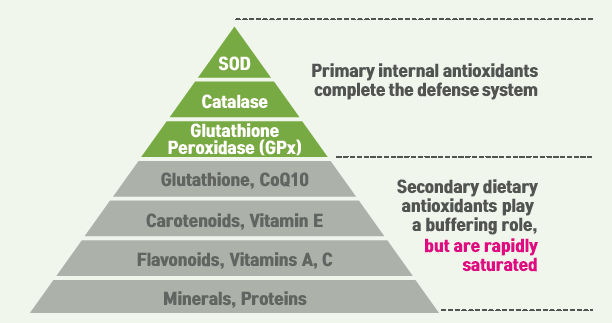
Primary antioxidants are made by the body, thus internally provided. This internal antioxidant defense system includes superoxide dismutase (SOD), catalase and glutathione peroxidase (GPx), which are the first, and most powerful, line of defense against oxidative stress.
Secondary antooxidants are externally provided from dietary sources, such as vitamins (vitamins A, C and E), minerals selenium, zinc, copper and manganese) and other substances, including polyphenols found in grapes and green tea. These dietary antioxidants contribute to the antioxidant reserve, yet play a secondary role to the body’s own antioxidants. But those are rapidly saturated.
- GF Bacillus SOD Technical Test Results Overview
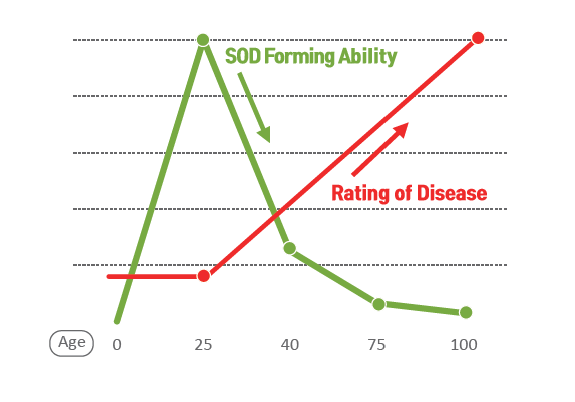
- It is now known that SOD levels drop while free radical levels increase as we age. As we age, internally generated reactive oxygen species ROS) gradually damage the molecular structure of the tissues, cells, proteins and even DNA.
- If the generation of free radicals exceeds the protective effects of antioxidants, and some co-factors, this can cause oxidative damage which accumulates during the life cycle, and has been implicated in aging, and age dependent diseases such as cardiovascular disease, cancer, neurodegenerative disorders, and other chronic conditions.
Levels of antioxidative enzymes in mice fed with GF SOD after 28 days

- The level of oxidative stress was increased, and the levels of antioxidative enzymes (SOD, catalase, and GPx) were decreased in the group treated with γ-irradiation as compared to the normal group.
- The oral administration of GF SOD had increased the levels of SOD, catalase, and GPx noticeably in both groups.
Levels of inflammatory cytokines in mice fed with GF SOD for 28 days
 As shown in the figure, treatment with γ-irradiation (oxidative stress) significantly increased the levels of IL-1β, TNF-α and IL-6 compared with the control. The administration of GF SOD appeared to decrease the production of these three inflammatory cytokines. This result demonstrated that oral supplementation of GF SOD could be used to alleviate oxidative stress and inflammation.
As shown in the figure, treatment with γ-irradiation (oxidative stress) significantly increased the levels of IL-1β, TNF-α and IL-6 compared with the control. The administration of GF SOD appeared to decrease the production of these three inflammatory cytokines. This result demonstrated that oral supplementation of GF SOD could be used to alleviate oxidative stress and inflammation.Anti-inflammatory effects of GF SOD on DSS-induced colitis in mice

The oxidative stress is involved in the pathogenesis of colitis. GF SOD was administered daily to mice treated with DSS for two weeks. In contrast to control mice treated with PBS for which DSS induced bleeding diarrhea and mucosal lesions, mice treated with GF SOD presented a significant reduction of colonic inflammatory scores.
Effects of oral administration of GF SOD on serum lipid profile in human
- Increased production of free radicals may cause oxidative damage on biological biomolecules, cell membranes and tissues.
- The free radicals induced oxidation of polyunsaturated fatty acids results in the formation of lipid peroxidation products.
- SOD can protect atheromatous lesions from oxidation by scavenging free radicals derived from polyunsaturated fatty acid components of low-density lipoprotein (LDL). And SOD activity and its correlation with serum glucose and lipid profile in diabetic patients and normal healthy controls have been reported recently.
- GF SOD improved the lipid profile in the plasma (i.e. decreased the levels of total cholesterol (TC), triglyceride (TG), and LDL). These results indicate that GF SOD shows positive effects on biomarkers associated with cardiovascular diseases, such as TC, LDL, and TG.
Normal Group

Abnormal Group


